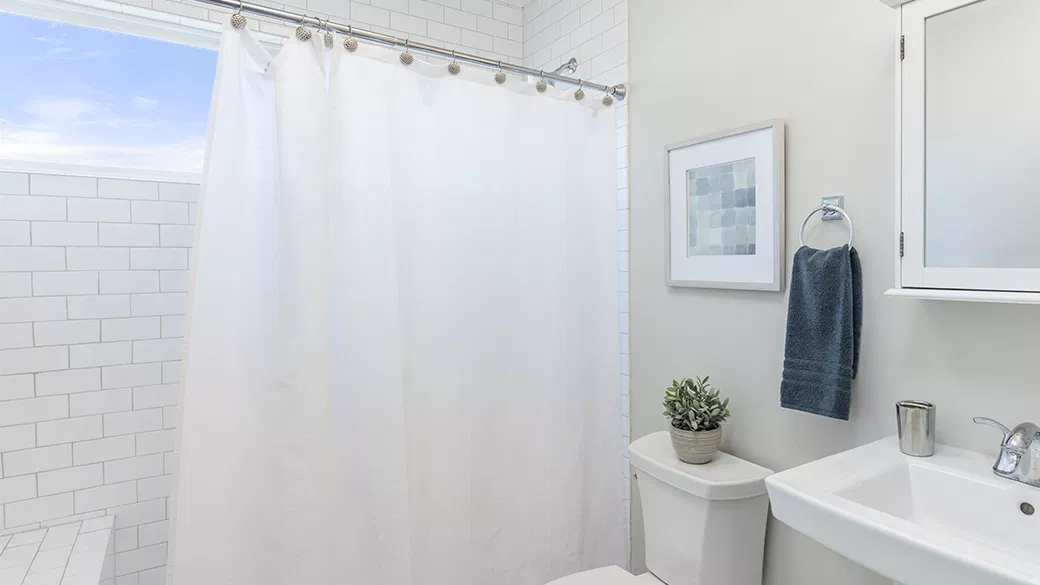What to Consider When Choosing a Shower Curtain?
When choosing the best shower curtain for your bathroom, there are a few crucial factors you should consider. These factors include material, style, durability, and practicality.
Material is one of the most important aspects of a shower curtain. It needs to handle moisture while being easy to maintain. OnlineHomeMag suggests that materials like PEVA, EVA, or polyester are ideal for moisture resistance and mold prevention, which is essential for high-humidity environments.
Style is another important consideration. The shower curtain should complement your bathroom’s overall aesthetic, whether you prefer minimalist, bold, or classic designs. Finding a balance between practicality and style is key to enhancing the look of your bathroom.

Durability is also crucial. Your shower curtain should withstand constant exposure to water, so it’s important to choose a high-quality material. Look for curtains that resist fading, staining, and moisture damage.
Practicality plays a large role as well. Features like weighted hems or hookless designs can make installation and maintenance much easier. These small details significantly improve the usability of your shower curtain.
By considering these factors, you can select a shower curtain that suits both the look and functionality of your bathroom.
Moisture Resistance and Mold Prevention
A bathroom is a space with high humidity, and your shower curtain needs to be able to withstand constant exposure to moisture. A curtain that traps moisture can easily become a breeding ground for mold and mildew, which not only looks unappealing but also creates an unhygienic environment. Therefore, moisture resistance should be at the top of your list when selecting the best curtains for the bathroom.
Materials like PEVA, EVA, and waterproof polyester are ideal for preventing mold growth. These materials are water-resistant, non-porous, and easy to wipe clean. Additionally, if you prefer fabric curtains, choosing one with a waterproof liner can be a smart solution. Liners made from polyester or plastic are highly effective at preventing water absorption.
Proper Sizing and Installation
The right size of your shower curtain ensures that it covers the entire shower area, preventing water from spilling onto the bathroom floor. Measure the width of your shower or bathtub and the height from the shower rod to the floor to determine the ideal size. Most shower curtains come in standard sizes, such as 72 x 72 inches, but you may need to opt for a custom size depending on the dimensions of your bathroom.
Installation is another important aspect. Make sure you have a sturdy shower rod or tension rod to hold your curtain securely. Depending on your preferences, you can choose between curtain rings, grommets, or hookless designs. Hookless curtains are a great option if you want to avoid the hassle of dealing with rings. They can be easier to install and tend to look more streamlined and modern.
Moisture Resistance and Mold Prevention
As mentioned earlier, moisture resistance is one of the most important factors when selecting the best curtains for the bathroom. Constant exposure to water and humidity can cause curtains to deteriorate over time, and mold can begin to form, especially in areas that don’t dry properly.

To prevent mold and mildew, it’s essential to choose a curtain made from materials that won’t absorb water. Plastic curtains like PEVA and EVA are popular for their water resistance and durability. These materials not only prevent water from seeping through but also have a smooth surface that’s easy to clean. PEVA, in particular, is a more eco-friendly option as it’s chlorine-free and made from non-toxic materials.
Polyester is another great material for moisture resistance. It is durable, affordable, and easy to maintain. Polyester fabric shower curtains often have a water-repellent coating that makes them resistant to moisture and prevents water from soaking into the fabric. However, fabric curtains require a bit more maintenance than plastic curtains because they are prone to absorbing moisture. A waterproof liner inside the fabric curtain can provide an added layer of protection against water penetration.
Mold Prevention Features
Some curtains come with additional mold-resistant treatments that can help prevent the growth of mold and mildew. Look for curtains labeled as “mold-resistant” or “anti-microbial.” These curtains are treated with special coatings or chemicals that resist mold buildup, ensuring your bathroom stays fresh and hygienic.
Lastly, always consider the bathroom ventilation in combination with your shower curtain choice. Installing an exhaust fan and ensuring the bathroom is properly ventilated will help reduce moisture buildup, preventing mold from becoming an issue.
Proper Sizing and Installation
Getting the correct size and installation of your shower curtain is crucial to its functionality and appearance. A poorly sized or incorrectly installed shower curtain can result in water leakage, making the bathroom messy and potentially damaging flooring or walls.
Measuring for Size
To determine the correct size, measure the width and height of your shower or bathtub area. The width of the curtain should match the width of your shower space to ensure proper coverage. Standard shower curtains typically measure 72 x 72 inches, but you may need a longer or wider curtain depending on your specific needs.
For a bathtub, choose a curtain that extends from the shower rod to just above the floor to avoid water splashing out. If you have a taller shower or a bathtub with a higher rim, you might need a longer curtain (usually 72 x 84 inches) to provide adequate coverage. For a sleek, modern look, many people choose curtains that just skim the floor.
Installation Options
Choosing the right installation method will depend on the type of rod or rail you’re using. Here are a few installation tips:
- Curtain Rods: A sturdy curtain rod should be placed slightly above the edge of the shower or bathtub. The rod should be strong enough to support the weight of the curtain.
- Tension Rods: If you prefer a no-drill option, tension rods are an excellent choice. They are easy to install and require no hardware. Tension rods are ideal for rental properties or bathrooms where you don’t want to make permanent alterations.
- Hookless Curtains: These curtains don’t require hooks or rings, making them easy to install and remove. Hookless curtains tend to look cleaner and more modern because there are no visible hooks or rings.
Matching with Bathroom Decor and Style
A shower curtain is more than just a functional item—it’s also an essential part of your bathroom’s decor. When choosing the best curtains for the bathroom, consider how the curtain complements your bathroom’s color scheme, style, and overall atmosphere.

Design and Pattern
Shower curtains come in various designs, ranging from minimalist to bold patterns. If you want your shower curtain to blend in with the bathroom’s theme, choose a neutral or simple design, such as solid colors, stripes, or subtle textures. Neutral tones like white, gray, or beige are always safe options that will complement most bathroom styles.
If you prefer to make a statement with your shower curtain, go for vibrant patterns or bold prints. Floral patterns, geometric shapes, or tropical designs can add a fun and refreshing touch to your bathroom. You can also opt for a curtain that features artistic prints or even one that matches seasonal themes, such as nautical designs for summer or cozy winter patterns.
Color Coordination
The color of your shower curtain should align with the colors already present in your bathroom. If your bathroom has neutral tones, a brightly colored or patterned curtain can add a pop of personality. For a more cohesive look, consider selecting a shower curtain that matches or complements the wall color, floor tiles, or other bathroom accessories, such as towels or rugs.
Fabric, Design, and Functional Features
Shower curtains are available in different fabrics, each offering unique benefits. Choosing the right fabric is essential to ensure that the curtain is functional and durable. Let’s explore the various fabric options and features:
Fabric Types
- Polyester: A durable, affordable, and water-resistant fabric, polyester is a popular choice for shower curtains. It’s machine washable and can withstand high humidity without becoming damaged. Polyester is often coated with a water-repellent finish, making it an excellent choice for moisture-prone bathrooms.
- Cotton and Linen: These fabrics offer a more luxurious feel and aesthetic appeal. Cotton and linen shower curtains are soft to the touch and often come in a variety of patterns and colors. However, they are more prone to absorbing water, which is why they need a liner for moisture protection.
- Plastic (PEVA/EVA): If you’re looking for an entirely waterproof option, PEVA and EVA plastic curtains are ideal. These materials are resistant to water, easy to clean, and inexpensive. They are a great choice for those who need a practical solution without sacrificing too much on design.
Functional Features
- Waterproof Liners: Many fabric curtains come with waterproof liners to enhance their moisture-resistance properties. Liners are typically made from plastic or polyester and help prevent water from soaking into the fabric.
- Weighted Hems: Curtains with weighted hems are less likely to shift or blow around during use. The added weight keeps the curtain in place, ensuring it doesn’t fly out of the shower or tub, especially if your bathroom has strong air ventilation.
- Magnetic Strips: Magnetic strips sewn into the bottom of a shower curtain can prevent water from escaping at the base of the curtain. This feature is particularly useful in preventing water from spilling onto the bathroom floor.
Types of Shower Curtains and Their Benefits
There are various types of shower curtains on the market, each designed to meet specific needs. Here are the most popular types and their benefits:
Waterproof Plastic Curtains (PEVA/EVA)
PEVA and EVA plastic curtains are completely waterproof, making them an excellent choice for bathrooms with high humidity. These materials are durable, easy to clean, and environmentally friendly. PEVA is a non-toxic, chlorine-free plastic, making it a safer option for households looking to avoid harmful chemicals.
Fabric Curtains with Waterproof Liners
For those seeking a more luxurious look, fabric curtains (cotton, polyester, or linen) can be paired with a waterproof liner for optimal moisture protection. These curtains are available in various designs, allowing you to choose the perfect one to match your bathroom decor.
Hookless Shower Curtains
Hookless curtains are becoming increasingly popular due to their ease of installation. These curtains eliminate the need for hooks or rings and are designed with built-in grommets, which means they can be directly hung on the rod.
A Buyer’s Guide – What to Look for When Buying a Shower Curtain?
When it comes to buying the best curtains for the bathroom, there are a few important factors to keep in mind. Start by measuring your shower space and ensuring that the curtain size will fit properly. Choose a fabric that suits your moisture-resistance needs, whether it’s a plastic curtain for complete water protection or a fabric one with a liner.
Pay attention to additional features, such as weighted hems, magnetic strips, or hookless designs. These features can enhance the curtain’s performance, ensuring that it stays in place and prevents water from spilling out. Also, check the curtain’s ease of maintenance—machine-washable options tend to be more convenient for regular cleaning.
Conclusion
In conclusion, selecting the best curtains for the bathroom is an essential step in creating a functional, aesthetically pleasing, and hygienic space. By considering factors such as moisture resistance, proper sizing, and how the curtain complements your bathroom’s style, you can make an informed decision. Choose a curtain material that suits your needs, whether it’s a durable plastic option or a fabric curtain with a waterproof liner, and don’t forget to factor in ease of installation and maintenance.
The right shower curtain not only serves its purpose of keeping water in check but can also become a key element of your bathroom’s decor. With the right choice, you can enjoy a stylish and well-protected bathroom for years to come.


